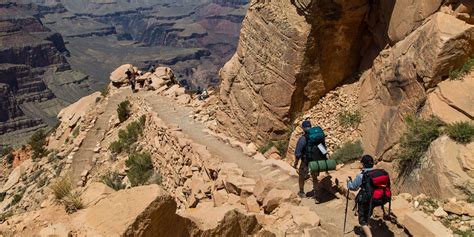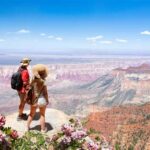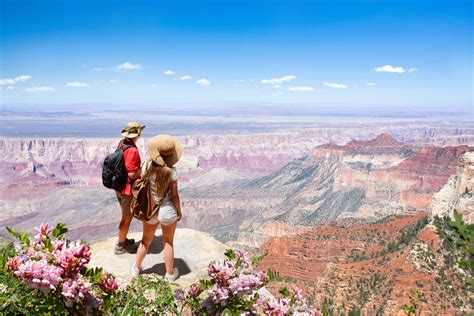
Hikers in the Grand Canyon National Park displayed compassion when they rescued a dehydrated hummingbird, providing it with sugar water after noticing its distressed state along the trail. The selfless act, captured in a now-viral video, highlights the fragility of wildlife in extreme environments and the positive impact of human intervention.
Grand Canyon Hikers Revive Dehydrated Hummingbird with Sugar Water
GRAND CANYON NATIONAL PARK, Ariz. – A group of hikers traversing the rugged trails of the Grand Canyon National Park recently encountered a tiny creature in dire need of assistance: a dehydrated hummingbird. The hikers, moved by the bird’s weakened condition, offered it a solution of sugar water, ultimately saving its life in a remarkable display of compassion and quick thinking. The incident, which was captured on video and shared widely on social media, serves as a potent reminder of the delicate balance of life within the Grand Canyon’s harsh environment and the potential for human kindness to make a significant difference.
The rescue unfolded as the hikers were making their way through a particularly arid section of the trail. According to the original report by Caters News Agency, the hikers noticed the hummingbird fluttering erratically near the ground, a clear sign of distress. Recognizing the signs of dehydration and exhaustion, they immediately sprang into action.
“We saw a hummingbird that was in distress and dehydrated on the trail,” one of the hikers, whose name was not released in the initial reports, told Caters News Agency. “We gave it some sugar water, and it drank for a long time.”
The video shows one of the hikers carefully holding a small container filled with sugar water close to the hummingbird’s beak. The tiny bird, initially hesitant, quickly began to drink, its delicate tongue darting in and out of the liquid. The hikers watched with bated breath, offering encouragement as the hummingbird slowly regained its strength.
The act of kindness resonated deeply with viewers online. The video, which was shared across various social media platforms, quickly went viral, garnering thousands of likes, comments, and shares. Many praised the hikers for their selfless actions and their willingness to help a creature in need.
“This is so heartwarming! Thank you for helping this little hummingbird,” one commenter wrote. “Such a beautiful reminder of the good in the world,” another added.
The incident underscores the importance of being aware of the wildlife that inhabits the Grand Canyon National Park and the challenges they face, particularly during periods of extreme heat and drought. Hummingbirds, with their high metabolism and dependence on nectar, are particularly vulnerable to dehydration.
The Significance of Hummingbirds in the Grand Canyon Ecosystem
Hummingbirds play a vital role in the Grand Canyon’s ecosystem. As pollinators, they are essential for the reproduction of many native plant species. They flit from flower to flower, sipping nectar and inadvertently transferring pollen, which allows plants to produce seeds and fruits. This pollination process is crucial for maintaining the biodiversity and health of the Grand Canyon’s plant communities.
The Grand Canyon is home to several species of hummingbirds, including the Anna’s hummingbird, the Black-chinned hummingbird, and the Rufous hummingbird. These tiny birds are adapted to survive in the canyon’s diverse habitats, from the rim to the inner canyon. However, they face numerous challenges, including habitat loss, climate change, and the increasing frequency of extreme weather events.
The Importance of Water Sources for Wildlife
Water is a precious resource in the arid environment of the Grand Canyon. Natural water sources, such as springs and seeps, are essential for the survival of many wildlife species, including hummingbirds. However, these water sources are often scarce and can be affected by drought and human activity.
Hikers and other visitors to the Grand Canyon can help protect wildlife by conserving water and avoiding disturbing natural water sources. It is also important to be aware of the signs of dehydration in animals and to take appropriate action if you encounter a creature in distress.
How to Help a Dehydrated Hummingbird
If you encounter a hummingbird that appears to be dehydrated, there are several steps you can take to help.
- Assess the situation: Observe the hummingbird’s behavior. Is it lethargic, disoriented, or unable to fly? These are all signs of dehydration.
- Offer sugar water: A simple solution of sugar water can provide the hummingbird with the energy it needs to recover. Mix one part white sugar with four parts water. Do not use honey, artificial sweeteners, or brown sugar, as these can be harmful to hummingbirds.
- Provide a shallow dish: Place the sugar water in a shallow dish or bottle cap. You can also use a hummingbird feeder, if available.
- Offer shade: If possible, move the hummingbird to a shaded area to protect it from the sun.
- Avoid handling: It is important to avoid handling the hummingbird unless absolutely necessary. If you must handle the bird, do so gently and carefully.
- Contact a wildlife rehabilitator: If the hummingbird does not improve after being given sugar water, or if it appears to be injured, contact a local wildlife rehabilitator for assistance.
The Grand Canyon National Park’s Response and Recommendations
The Grand Canyon National Park officials have praised the hikers’ actions, emphasizing the importance of responsible wildlife encounters. They remind visitors to observe wildlife from a distance, avoid feeding animals, and pack out all trash.
“We appreciate visitors who are mindful of the park’s resources and take actions to protect wildlife,” a park spokesperson said. “It’s important to remember that the Grand Canyon is a fragile ecosystem, and we all have a role to play in preserving it.”
The park service also encourages visitors to carry water and be aware of the signs of heat stress, both in themselves and in the animals they encounter. They recommend reporting any injured or distressed wildlife to park rangers.
Broader Context: Environmental Stressors on Hummingbirds
The incident with the hummingbird in the Grand Canyon highlights the increasing challenges faced by these birds due to environmental stressors. Climate change, habitat loss, and pesticide use are all contributing to the decline of hummingbird populations in some areas.
- Climate Change: Rising temperatures and changes in precipitation patterns can disrupt the timing of flowering events, making it difficult for hummingbirds to find the nectar they need. Extreme weather events, such as droughts and heatwaves, can also lead to dehydration and starvation.
- Habitat Loss: As human development expands, hummingbird habitats are being destroyed and fragmented. This reduces the availability of nesting sites, food sources, and shelter.
- Pesticide Use: Pesticides can kill insects that hummingbirds rely on for protein, especially during the breeding season. They can also contaminate nectar and pollen, poisoning hummingbirds directly.
Conservation Efforts and How to Contribute
Numerous organizations are working to protect hummingbirds and their habitats. These efforts include habitat restoration, research and monitoring, and public education. Individuals can also play a role in hummingbird conservation by:
- Planting native flowers: Native plants provide hummingbirds with a reliable source of nectar and attract the insects they need for protein.
- Avoiding pesticide use: Use natural pest control methods instead of pesticides.
- Providing water: Offer hummingbirds a shallow dish of water or a hummingbird feeder.
- Supporting conservation organizations: Donate to or volunteer with organizations that are working to protect hummingbirds.
- Educating others: Share information about the importance of hummingbirds and the threats they face.
The actions of the Grand Canyon hikers serve as an inspiration, demonstrating the positive impact that individuals can have on the lives of animals in need. By being mindful of our surroundings and taking simple steps to help, we can all contribute to the conservation of hummingbirds and other wildlife.
The Viral Impact and Social Media’s Role
The rapid spread of the hummingbird rescue video underscores the power of social media to raise awareness about environmental issues and inspire acts of kindness. The video’s viral success can be attributed to several factors:
- Emotional Appeal: The video depicts a vulnerable creature in need of help, eliciting empathy and compassion from viewers.
- Positive Message: The story highlights the positive impact of human intervention, offering a counterpoint to the often-negative news about environmental degradation.
- Shareability: The video is short, visually appealing, and easy to share across various social media platforms.
Social media can be a powerful tool for promoting conservation efforts and encouraging responsible interactions with wildlife. By sharing stories of hope and inspiration, we can inspire others to take action and make a difference.
Legal Considerations and Park Regulations
While the hikers’ intentions were undoubtedly good, it’s important to consider the legal and ethical implications of interacting with wildlife in national parks. Grand Canyon National Park, like all national parks, has regulations in place to protect wildlife and their habitats.
According to the National Park Service, it is illegal to feed, touch, tease, frighten, or intentionally disturb wildlife. This is because such actions can alter their natural behavior, make them dependent on humans, and expose them to disease.
In the case of the hummingbird rescue, the hikers’ actions could be seen as a violation of these regulations. However, park officials have generally taken a lenient approach, recognizing that the hikers were acting out of compassion and that their intervention likely saved the bird’s life.
It’s important for visitors to understand the park’s regulations and to exercise caution when interacting with wildlife. If you encounter an animal in distress, it’s best to contact park rangers for assistance. They are trained to handle such situations and can provide the animal with the appropriate care.
The Future of Hummingbirds in a Changing World
The future of hummingbirds is uncertain, as they face numerous threats from climate change, habitat loss, and other environmental stressors. However, there is still hope for their survival, thanks to the efforts of conservation organizations, researchers, and individuals who are committed to protecting these amazing creatures.
By understanding the challenges that hummingbirds face and taking steps to mitigate these threats, we can help ensure that they continue to thrive in the Grand Canyon and around the world. This requires a collective effort, involving governments, businesses, and individuals, to address the root causes of environmental degradation and promote sustainable practices.
The story of the Grand Canyon hikers and the dehydrated hummingbird serves as a reminder that even small acts of kindness can make a big difference. By being mindful of our impact on the environment and taking action to protect wildlife, we can create a more sustainable future for all.
FAQ: Hummingbird Rescue in the Grand Canyon
1. What exactly happened with the Grand Canyon hikers and the hummingbird?
A group of hikers in the Grand Canyon National Park found a hummingbird in distress, showing signs of dehydration. Recognizing the bird’s condition, they offered it sugar water, which revived the bird and allowed it to recover. The incident was captured on video and went viral on social media.
2. Why was the hummingbird in distress?
The Grand Canyon environment can be extremely harsh, especially during hot and dry periods. Hummingbirds have high metabolisms and require frequent access to nectar and water. Dehydration can quickly affect them, particularly if natural water sources are scarce.
3. What did the hikers do to help the hummingbird?
The hikers mixed a solution of sugar water (one part sugar to four parts water) and offered it to the hummingbird in a small container. The hummingbird drank the solution, which helped it rehydrate and regain its strength.
4. Is it legal to feed wildlife in national parks?
Generally, feeding wildlife in national parks is discouraged and often illegal, as it can alter their natural behaviors and create dependency on humans. However, in this instance, the hikers’ actions were seen as an emergency intervention to save the bird’s life, and park officials have acknowledged the positive outcome.
5. What can I do if I find a distressed hummingbird?
If you find a distressed hummingbird, you can offer it sugar water (one part sugar to four parts water) in a shallow dish. Provide shade and avoid handling the bird unless absolutely necessary. If the bird doesn’t improve or appears injured, contact a local wildlife rehabilitator or park rangers for assistance.
6. What are some of the threats facing hummingbird populations?
Hummingbirds face various threats, including habitat loss, climate change (which can disrupt flowering patterns), pesticide use (which can kill their insect food sources), and extreme weather events like droughts and heatwaves.
7. What kind of sugar should I use for hummingbird food?
Use plain white granulated sugar. Do not use honey, brown sugar, artificial sweeteners, or anything with dyes or preservatives, as these can be harmful to hummingbirds.
8. What should I do if a hummingbird feeder is attracting bees or ants?
To deter bees, use a hummingbird feeder with small feeding ports that bees can’t access easily. You can also move the feeder slightly each day, as bees will have trouble finding it again. To prevent ants, use an ant moat (a small cup of water above the feeder) to create a barrier.
9. How often should I clean my hummingbird feeder?
Clean your hummingbird feeder every 2-3 days, especially in hot weather, to prevent the growth of mold and bacteria that can harm hummingbirds. Use hot water and a bottle brush to scrub the feeder thoroughly.
10. What are some plants I can grow to attract hummingbirds?
Some plants that attract hummingbirds include salvia, bee balm, trumpet vine, honeysuckle, and columbine. Choose native plants whenever possible, as they are best adapted to your local climate and provide the most beneficial nectar for hummingbirds.
11. Are there different species of hummingbirds in the Grand Canyon?
Yes, several species of hummingbirds can be found in the Grand Canyon, including Anna’s hummingbird, Black-chinned hummingbird, and Rufous hummingbird. The specific species present may vary depending on the time of year and elevation.
12. How can I support hummingbird conservation efforts?
You can support hummingbird conservation by planting native flowers, avoiding pesticide use, providing water sources, supporting conservation organizations, and educating others about the importance of hummingbirds and the threats they face.
13. What is the National Park Service’s policy on interacting with wildlife?
The National Park Service generally discourages interacting with wildlife, including feeding, touching, or disturbing animals. Visitors are advised to observe wildlife from a distance and report any injured or distressed animals to park rangers.
14. How does climate change impact hummingbirds?
Climate change can disrupt the timing of flowering events, making it difficult for hummingbirds to find the nectar they need. Extreme weather events, such as droughts and heatwaves, can also lead to dehydration and starvation.
15. How does pesticide use affect hummingbirds?
Pesticides can kill insects that hummingbirds rely on for protein, especially during the breeding season. They can also contaminate nectar and pollen, poisoning hummingbirds directly.
16. What other animals share similar water needs in the Grand Canyon?
Many animals in the Grand Canyon, including desert bighorn sheep, lizards, and various bird species, rely on limited water sources and can be vulnerable to dehydration, especially during dry periods.
17. What is the best time of year to see hummingbirds in the Grand Canyon?
The best time of year to see hummingbirds in the Grand Canyon is generally during the spring and summer months when flowers are in bloom and food sources are abundant.
18. Where can I learn more about Grand Canyon National Park’s wildlife policies?
You can learn more about Grand Canyon National Park’s wildlife policies by visiting the park’s website or contacting park rangers directly. The website provides information on park regulations, safety guidelines, and conservation efforts.
19. Should I approach an injured or distressed animal in the Grand Canyon?
It’s generally best to avoid approaching an injured or distressed animal in the Grand Canyon. Instead, observe the animal from a safe distance and report its location to park rangers. They are trained to handle such situations and can provide the animal with the appropriate care.
20. What role do hummingbirds play in the Grand Canyon ecosystem?
Hummingbirds play a crucial role in the Grand Canyon ecosystem as pollinators. They help to fertilize many native plant species, which is essential for the reproduction and survival of these plants. This pollination process contributes to the biodiversity and health of the canyon’s plant communities.









